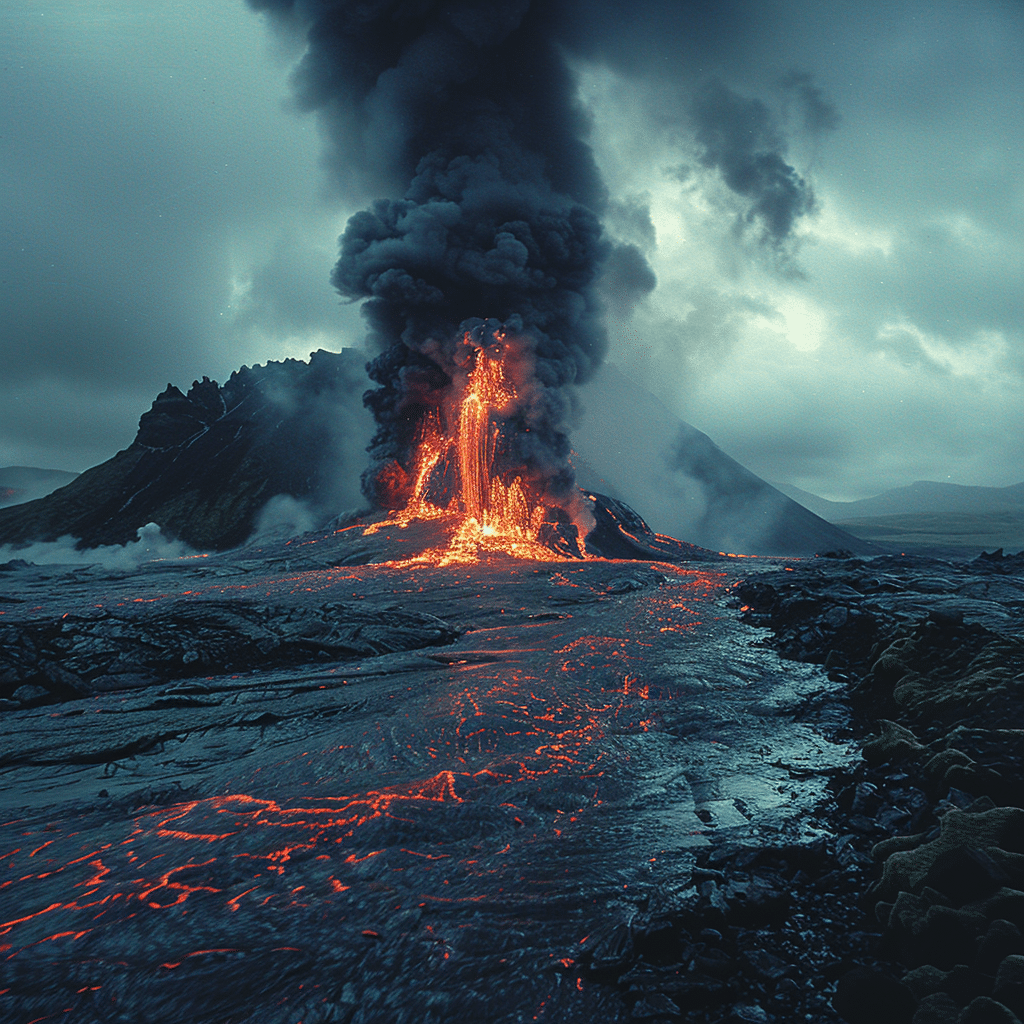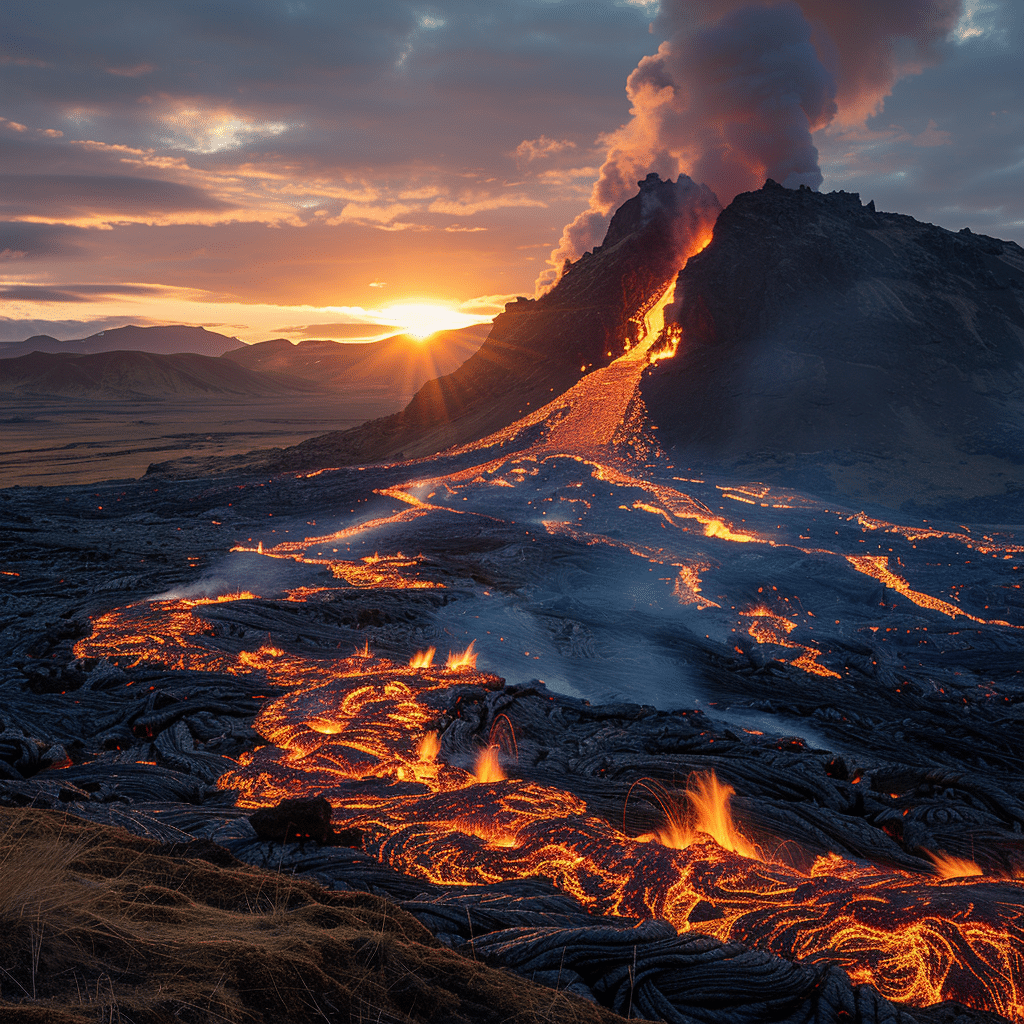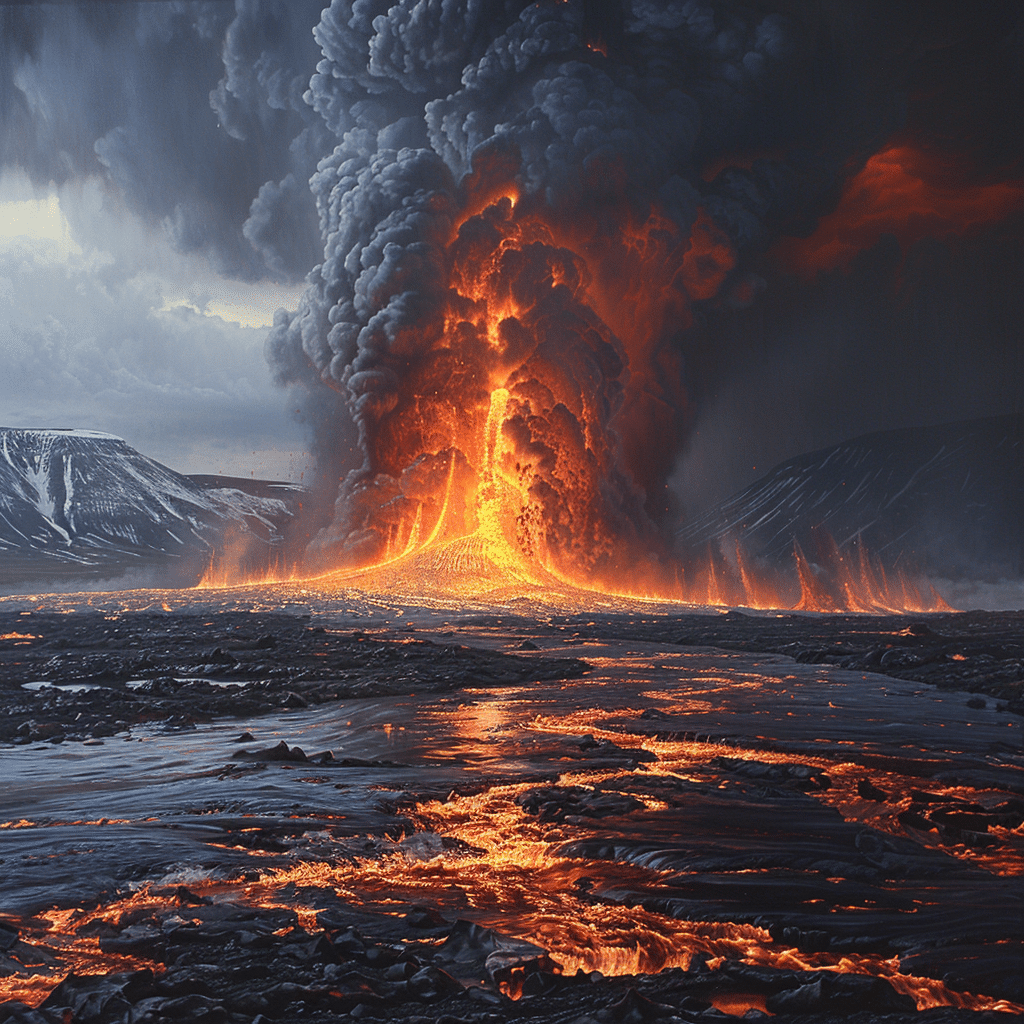The Current Eruption: An Overview
In early 2024, Iceland witnessed yet another remarkable natural event as one of its volcanoes erupted. This eruption has dominated the headlines globally, capturing attention due to its intensity and strategic location. Nestled between tectonic plates, Iceland’s volcanoes are no strangers to dramatic eruptions. However, the current one is noteworthy due to its proximity to tourist hotspots and its substantial impact on local communities and international travel.
Lava is currently flowing from a single active crater, primarily to the north of Mt. Sýlingarfell. Some lava accumulates southwards, while uplift continues in the area around Svartsengi. Despite its spectacular display, it’s essential for travelers to heed local warnings and follow safety advice for a safe journey.
Impact on Tourist Attractions: The Blue Lagoon Amidst the Iceland Volcano Eruption
The Blue Lagoon, Iceland’s famed geothermal spa, hasn’t been spared from this volcanic turmoil. Situated close enough to the erupting volcano, it has faced temporary shutdowns and strict preventive measures to protect its visitors. The management of the Blue Lagoon is offering full refunds and rescheduling options, showing resilience and commitment to customer satisfaction.
Despite these disruptions, the volcanic activity around the Blue Lagoon has created a unique spectacle. The serene blue waters set against the ominous glow of flowing lava have yielded a surreal, almost otherworldly landscape. This unique scene has attracted photographers and adventure-seekers from all over the world, putting the Blue Lagoon into the spotlight like never before.

| Date | Event Description | Location | Safety Advice | Impact on Travel |
|---|---|---|---|---|
| 18.6.2024 | Eruption ongoing, lava flowing mostly to the northeast. | Mt. Sýlingarfell | Respect local restrictions, avoid Grindavik. | Keflavik International Airport and access roads unaffected. |
| 12.6.2024 | Eruption ongoing with uplift in Svartsengi. Lava mostly to the north. | Svartsengi, Mt. Sýlingarfell | Advised to stay away from Grindavik and follow updates from the Icelandic Met Office. | No significant disruptions; Iceland generally safe. |
| May 29, 2024 | Travellers can visit Iceland safely, avoiding the eruption area. | Iceland (Reykjanes Peninsula) | Follow advice from Safe Travel Iceland and local authorities. | Keflavik Airport operating normally; unaffected roadways. |
| 2021-Present | Multiple volcanic events since 2021. Current eruptions not dangerous if safety measures are adhered to. | Reykjanes Peninsula | Always follow the Icelandic Met Office guidance and safety advice. | Tourist infrastructures operational, except near eruption zones. |
Eyjafjallajökull vs. Today: Comparing Past and Present Eruptions
The eruption of Eyjafjallajökull in 2010 serves as a benchmark for modern volcanic eruptions in Iceland. That event’s massive ash cloud caused significant global travel disruptions, which informed better emergency responses today.
The current eruption has benefited from those lessons, seeing faster implementation of no-fly zones, more efficient evacuations, and better communication systems. Scientists have harnessed advanced monitoring technology to predict eruption patterns more accurately, making precise and timely warnings possible.
Local Communities: Resilience and Challenges
Residents living near the volcano, like those in Grindavík, display remarkable resilience amidst adversity. The authorities closely coordinate with the Icelandic Meteorological Office and Civil Protection Department, ensuring everyone’s safety. Economic implications are undeniable, especially for those in tourism and agriculture, as they adapt to fluctuating demands and disruptions.
Livestock farmers are moving their animals to safer pastures, and hotels are adjusting to varying tourist numbers. Still, the sense of community remains strong, with locals supporting one another through these challenging times.

Geopolitical and Environmental Implications
The eruption’s environmental impact is becoming increasingly evident. Volcanic gases, including sulfur dioxide, are causing worries about air quality and its effects on climates locally and globally. Environmental scientists continue to study long-term repercussions on agriculture, water sources, and overall air quality.
Geopolitically, Iceland’s role as a midpoint for air travel between North America and Europe is highlighted. Eruptions like this significantly threaten air travel, necessitating swift adaptations from airlines, including Icelandair and WOW air, to reroute flights safely.
Future Eruptions: Preparedness and Prediction
Discussion about future eruptions abounds among geologists and volcanologists. By analyzing patterns, historical data, and current activities, experts work on improving their predictive models. Satellite imagery, ground sensors, and AI computing have significantly advanced the accuracy of these predictions.
Iceland’s emergency infrastructure and public awareness campaigns emphasize preparedness. Thanks to regular drills and educational initiatives, both residents and tourists are well-prepared to respond effectively to volcanic activity.
Perspectives from the Ground: First-Hand Accounts
Several residents and tourists have shared their firsthand experiences, painting a vivid picture of life amidst the eruption. Jóhann, a local guide, spoke of evacuating his family and livestock, commending the swift actions of emergency services. “It’s surreal and frightening, yet we’re used to the land being alive beneath our feet,” he said.
Sarah, a Canadian tourist, marveled at the eerie beauty of the volcanic landscape. “It’s a once-in-a-lifetime view. The lava, the sky, the emotions—it’s overwhelming but also deeply humbling to witness nature’s raw power,” she added.
Final Thoughts: Embracing the Unpredictable
The 2024 Icelandic volcano eruption epitomizes the ongoing dynamism of our planet. While it poses significant challenges and disruptions, it also highlights human resilience, scientific advancements, and the awe-inspiring majesty of nature. As Iceland continues adapting to these fiery events, the world observes, learns, and marvels at the blend of natural wonder and human determination.
This article offers a comprehensive journey through the 2024 eruption, capturing the broader human, environmental, and geopolitical narratives. It stands as a testament to the unyielding spirit of Iceland and the remarkable advancements in science, underscoring that in the face of nature’s unpredictable might, life persists and adapts.
For related reads, check out our in-depth stories on new balance 327, Foto Negra, and how russian Threats ohio Schools shaped local responses.
Iceland Volcano News: Ongoing Lava Eruption Unfolds
Fun Trivia and Interesting Facts
Ever heard a song twice and suddenly associate it with something completely different? Now, imagine humming Dolly Parton’s Jolene Lyrics while observing the raw power of Iceland’s volcanic eruptions. What’s the connection? Well, just like the song’s plea of desperation, there’s both beauty and urgency in the spectacle of lava flowing. The eruption in Iceland is a breathtaking yet volatile display of nature’s force, much like the soulful narrative in “Jolene.
Interestingly enough, the geological transformation from volcanic eruptions has given rise to some of the most unique landscapes on Earth, a spectacle comparable to the mesmerizing pink sand beach in the Bahamas. Iceland’s dynamic topography, shaped by continuous volcanic activity, creates an array of breathtaking vistas, from black sand beaches to lava fields. This constant reshaping of the land truly reflects nature’s artistry at its finest.
Now, here’s a fun twist – if you’re fascinated by volcanoes and consider this field your calling, check out Marshalls Hiring. Who knows, maybe your next adventure involves working in close proximity to these powerful natural wonders. Working near or even studying a volcanic eruption can be both exciting and perilous, offering an opportunity to witness Earth’s crust literally in motion.
And hey, speaking of boxes of surprises, why not think of volcanic eruptions as Mother Earth’s own gift Boxes? Each eruption reveals new geological formations, much like opening a box to find something surprising inside. While often destructive, eruptions can also introduce new minerals and reshape the eco-system in unexpected ways.
So there you have it – witnessing the magnificence of lava flows in Iceland is not just a geologic curiosity but a vibrant, living canvas painted by nature’s hand. And while you’re at it, you might want to calculate how fit you’d need to be for an adventurous hike over lava fields using an Acft calculator. Who knew volcano watching could be so seamlessly processed with everyday life and trivia?

Is the volcano still flowing in Iceland?
Yes, the volcano is still flowing in Iceland, with lava coming out of one crater. The flow is mostly going to the northeast, but some lava accumulates to the south of the crater.
What’s the latest on the Iceland volcano?
The Iceland volcano is erupting steadily with one active crater, predominantly sending lava flows to the north.
Is it safe to travel to Iceland with the volcano?
It’s safe to travel to Iceland as long as you steer clear of Grindavik and follow local restrictions and advice from the Icelandic Met Office and Safe Travel Iceland.
Is it safe to go to Iceland right now?
Iceland is a safe destination right now, except for areas close to the ongoing volcanic eruption.
Is the Blue Lagoon affected by the volcano eruption?
The Blue Lagoon is not affected by the volcanic eruption and remains open for visitors.
Is Fagradalsfjall still erupting?
Fagradalsfjall continues to erupt, with an active crater emitting steady lava flows.
Is the Iceland volcano still erupting in 2024?
Yes, the volcano in Iceland is still erupting in 2024, maintaining a stable flow from one active crater.
What language do they speak in Iceland?
Icelandic is the official language spoken in Iceland.
Can I still go to Iceland?
You can still go to Iceland; just make sure to avoid restricted areas near the volcano and follow local safety guidelines.
Is it safe to go to the Blue Lagoon?
Visiting the Blue Lagoon is safe, and the area hasn’t been impacted by the eruption.
How far from Reykjavik is the erupting volcano?
The erupting volcano is located about 30 kilometers (19 miles) from Reykjavik.
Should I cancel my trip to Iceland?
No need to cancel your trip to Iceland as it’s generally safe; just adhere to travel safety advice and avoid the volcanic regions.
Is it safe to fly to Reykjavík?
It’s safe to fly to Reykjavík, with Keflavik International Airport running normally without any disruptions due to the volcano.
What happens if the Iceland volcano erupts?
If the Iceland volcano erupts, affected areas might be restricted, but outside those zones, life goes on as usual. Follow safety recommendations and avoid hazard zones.
Is there a bad time to visit Iceland?
There’s no bad time to visit Iceland, but winter can be very cold and summer can be crowded with tourists.
Is the volcano in Iceland still erupting in 2024?
Yes, the volcano in Iceland is still erupting in 2024 with ongoing lava flow from one crater.
Is the volcano still erupting?
Indeed, the volcano is still erupting, with continuous lava flow from one active crater.
Can you hike to the new eruption in Iceland?
Currently, you’re advised to stay away from the eruption site for safety reasons, and hiking to the new eruption is not recommended.
Can you visit the active volcano in Iceland?
For safety reasons, visiting the active volcano in Iceland is discouraged. It’s best to check with local authorities for updated information.



